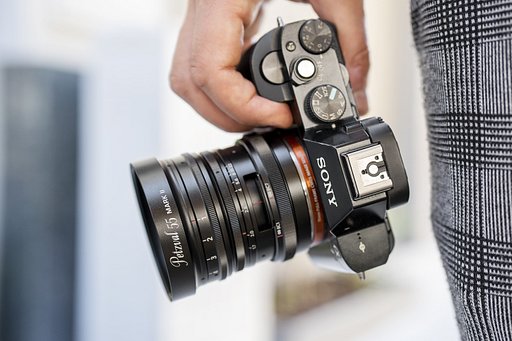Subject in Movement with Ben Bradish-Ellames and the Lomo LC-A 120
4 Share TweetUK-based photographer and filmmaker Ben Bradish-Ellames has established his style as a fashion portrait photographer, working with magazines such as Cool America, Flannell and Noctis Magazine. He also specializes in capturing the movement, posture and performance of dancers and regularly shoots with medium format and large format film. Ben uses a studio setting juxtaposed with the freedom and serendipity that occurs when shooting with film to create natural looking photos which have a rich and subtly analogue aesthetic. We asked Ben to test out the Lomo LC-A 120 camera with some LomoChrome Purple 120 and Lomography Color Negative 400 120 film, which he tried out in a studio setting using long exposures.
Hi Ben, please tell us a bit about yourself.
I’m a professional photographer, based in London, UK. I specialize in photographing mainly dance and movement, but recently have been shooting fashion work too – mainly when linked to movement. As an avid film lover, I also run a London based non-for-profit darkroom, supporting current photographers and print makers.
How would you describe your photography style?
Ah a tricky question, probably best answered by others. I’m not sure how I would describe my style as such, but what I look for in my photographs is to strip them back to a bit of simplicity. Given how a subject in movement needs to be the main focus in my photographs, I spend a lot of time paying attention to colors used. Repetition of colors, tones, and no more than three colors in a photo – ideally. Also I am really interested in shapes, so I really try to pay attention to interesting shapes generated in movement. With my black and white work, I am a big fan of black blacks, and loss of detail. It creates a real feeling. Then spending time capturing all details in mid-tones and highlights….if that’s a style.

What was the idea behind these photos and how did you prepare for the shoot?
Well, a significant amount of my work is shot in the studio, and the LC-A 120 definitely isn’t a studio camera. But I really wanted to try and figure out a method in which I could try to shoot it as a studio camera, and see some different results to how the camera is usually used. Because the LC-A 120 has automated variable shutter speeds and aperture, an element of control that you need in the studio is taken away from you.
But I really wanted to put the LC-A in an environment alien to it. I really had no idea if this would work or not. But with a tripod, some continuous lighting, and also a flash (strobe) light, I was able to force the LC-A shutter to be open for as long as possible, and then manually fire the flash/strobe light to try and capture my subject.
How did you find the results from the LC-A 120 and Lomo film?
I was amazed and completely taken aback that it actually worked. The hit rate was definitely about one photo in two that came out. But – that didn’t matter, I really didn’t think the method would have worked one bit, as there was a lot of guesstimation that took place. But I was able to shoot the camera in a studio environment, and get great results that still have a semblance to shooting an LC-A 120.
Additionally, I really did like the films I was using too. The LomoChrome Purple looked nicely desaturated, and the Color Neg 400, there are some nice yellows and blue undertones – even though the main color shot was red. I definitely did slightly overexpose the films, as I was keeping the automated shutter open, but from this I would say that both films are quite light thirsty, and the colors really pop when they get plenty of light. Normally I would print my film to see what it looks like, and when I have the time I will get around to doing it. But for these results I scanned the film, and they both looked like they scan well. So yeah, all in all, really happy!
Any tips for other photographers wanting to shoot dancers or moving figures with film?
Just go for it! Easier said than done I know! But I guess a few pointers that I always stuck to. Firstly, forget about movement or movements per se, and just focus on interesting shapes. If you are photographing any kind of dancer, don’t get them to hold static shapes/poses, as your photos will look staged. Just get them to perform 4-5 movements with transitions. Watch it first, then shoot it when performed a second, third, fourth time. You’ll find it is the interesting shapes that produce the best photographs, not the correct movements/poses. And if it helps, my actual knowledge of dance is zero. I just know what makes for interesting shapes.
Secondly, just accept that your hit rate on film is not going to be 100%. More likely 50% when you start out. This can be tricky to accept, especially given the sharp rises in cost of film. But you can quickly get your hit rate up by practicing. I have found the versatility of film makes shooting movement much more fascinating, than if you were to shoot it digital, and have everything looking too perfect.
Thirdly, actually it doesn’t all have to be in focus. Because, if you stick to looking for interesting shapes, a soft focus is beautiful. (Remarkably, my two most successful photos of my career, both happen to be out of focus.) Lastly… crop in! Shoot a dance or movement scene wider than you need to, and then crop in on the scan/print. You’ll find incredible body form and textures.
To see more of Ben's work, visit his website and Instagram page.
2024-02-27 #news #people #medium-format #movement #dancing #dancers #united-kingdom #lca120




























No Comments